Last September, eHang announced their EH216 is close to certification by the Civil Aviation Authority of China (CAAC) and revealed some astounding numbers.
The EH216 (two seats, 16 rotors) has over 30,000 safe flights to its credit. An even stronger sign that eHang is headed toward commercial operations – its safety video. You don’t need to be conversant in Mandarin or Cantonese to get it. Preparing for customer operations is a clear sign of intent.
According to eHang, a “Project Specific Certification Plan has been officially approved by the Civil Aviation Administration of China (“CAAC”). At present, various specified review subjects have been confirmed, including performance and flight, structural strength, design and configuration, ground control station, airborne human-computer interaction, totality, continued airworthiness, etc., and activities for demonstration and verification of compliance are being prepared.” Final tests and validation will follow, with certification expected by this fall.
They are preparing passengers for a professional, slick experience, and setting expectations at a comforting level. One will snuggle into an eHang with the familiar type of airline expectancy, a reassuring sense that we’ve been here before and that everything will be OK. Better than the airline experience, though, you’ll probably have an affable traveling companion.
Passenger Carrying Flight in Japan
This flight is the latest in eHang’s World Tour, a series of outings in countries from Estonia to Austria to Bali to South America, with many passengers getting their first exposure to automated aerial transport. As we can see in the video of Japan’s first such trip, people seem less threatened by and more enthusiastic toward the idea.
Unique Missions with the Spanish National Police
They’ve even caught the attention of Spanish law enforcement, intimating some uniquely specific missions in the pod’s future. The Spanish National Police (SNP), envisions their “potential use in emergency and public safety missions, such as accessing contaminated areas with nuclear, radiological, bacteriological or chemical risks, landing in confined areas, aerial logistics, and other police services that may require agile and efficient aerial mobility.”
In December last year, a “public maiden flight ceremony was attended and witnessed by distinguished guests and officials from the Spanish State for Security, SNP, the Spanish State Aviation Safety Agency (“AESA”), members of academia institutions, as well as the media.”
Besides police forces, eHang is looking at medical transport, fire, and other civil applications.
Coming to the U. S.?
This short video hints at eHang opening operations here, but doesn’t give a time-line or any detail on when the FAA will make that possible. Despite a demonstration flight at Kitty Hawk, North Carolina in 2019, we haven’t seen any subsequent flights, or news of regulatory progress.
Meeting New Criteria
eHang is part of a European Union Agency for the Space Program (EUSPA), the “SBAS (EGNOS) Adoption in Multicopter VTOL Aircraft (“SAMVA”) project, for deploying European Geostationary Navigation Overlay Service (“EGNOS”) on electrical Vertical Take Off and Landing (“eVTOL”) aircraft operations, such as EH216 AAVs, across the continent. ”
SAMVA will implement EGNOS satellite-based operations on eVTOLs to enhance Advanced Air Mobility services and U-Space airspace integration. The project consortium includes Aeroports de Catalunya, EHang, Pildo Labs, the Airports Regional Council, Thales-Alenia Space, and Eliance. The group will establish an operational center at Lleida-Alguaire airport, “to conduct EH216 flight demonstrations with EGNOS deployment and showcase how EGNOS can support and enhance Unmanned Aircraft System Traffic Management (“UTM”) tasks and AAV urban operations.”
eHang is obviously using its success as a drone manufacturer and a growing network of affiliates to strengthen what could be a worldwide deployment of two-passenger urban air vehicles. This will certainly be a challenge to others.

